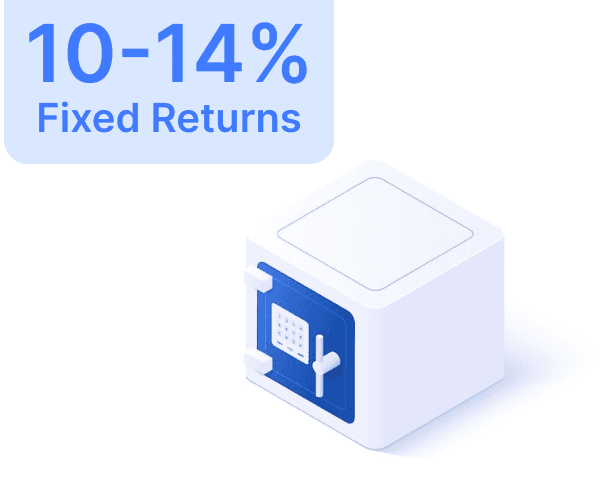Closed Ended Funds



Introduction
Introduction
Introduction
Introduction
Mutual Funds can be classified based on their structure into three types: open-ended, closed-ended, and interval funds. This classification is based on the frequency with which you can buy or sell units of the scheme. Open-ended funds are more common and popular among investors because they can be traded without restrictions. However, closed-ended funds are also gaining traction. In this discussion, we will explore Closed-Ended Mutual Funds, examining the different types available in India, their benefits, and much more.
Mutual Funds can be classified based on their structure into three types: open-ended, closed-ended, and interval funds. This classification is based on the frequency with which you can buy or sell units of the scheme. Open-ended funds are more common and popular among investors because they can be traded without restrictions. However, closed-ended funds are also gaining traction. In this discussion, we will explore Closed-Ended Mutual Funds, examining the different types available in India, their benefits, and much more.
Mutual Funds can be classified based on their structure into three types: open-ended, closed-ended, and interval funds. This classification is based on the frequency with which you can buy or sell units of the scheme. Open-ended funds are more common and popular among investors because they can be traded without restrictions. However, closed-ended funds are also gaining traction. In this discussion, we will explore Closed-Ended Mutual Funds, examining the different types available in India, their benefits, and much more.
Advantages of Closed-Ended Mutual Funds
Advantages of Closed-Ended Mutual Funds
Advantages of Closed-Ended Mutual Funds
Advantages of Closed-Ended Mutual Funds
Here are some key advantages of closed-ended mutual funds:
Stability for Fund Managers
In a closed-ended fund, investors cannot redeem their units before the maturity date. This provides fund managers with a stable asset base to work with, eliminating concerns about maintaining liquidity. As a result, fund managers can focus on developing strategies to achieve the investment objectives of the scheme.
Market Price Based on Demand and Supply
Similar to equity shares, the units of closed-ended schemes are traded on the stock exchange at prices determined by the demand and supply of the units. If the demand for a particular closed-ended scheme increases while supply remains low, the units can be sold at prices significantly above the scheme's NAV.
High Liquidity
Although closed-ended funds might initially seem illiquid since the fund house does not allow redemption of units, the stock exchange provides ample opportunities to buy and sell units. In fact, closed-ended funds offer a high degree of liquidity, allowing investors to trade units on the stock exchange at prevailing market prices.
Here are some key advantages of closed-ended mutual funds:
Stability for Fund Managers
In a closed-ended fund, investors cannot redeem their units before the maturity date. This provides fund managers with a stable asset base to work with, eliminating concerns about maintaining liquidity. As a result, fund managers can focus on developing strategies to achieve the investment objectives of the scheme.
Market Price Based on Demand and Supply
Similar to equity shares, the units of closed-ended schemes are traded on the stock exchange at prices determined by the demand and supply of the units. If the demand for a particular closed-ended scheme increases while supply remains low, the units can be sold at prices significantly above the scheme's NAV.
High Liquidity
Although closed-ended funds might initially seem illiquid since the fund house does not allow redemption of units, the stock exchange provides ample opportunities to buy and sell units. In fact, closed-ended funds offer a high degree of liquidity, allowing investors to trade units on the stock exchange at prevailing market prices.
Here are some key advantages of closed-ended mutual funds:
Stability for Fund Managers
In a closed-ended fund, investors cannot redeem their units before the maturity date. This provides fund managers with a stable asset base to work with, eliminating concerns about maintaining liquidity. As a result, fund managers can focus on developing strategies to achieve the investment objectives of the scheme.
Market Price Based on Demand and Supply
Similar to equity shares, the units of closed-ended schemes are traded on the stock exchange at prices determined by the demand and supply of the units. If the demand for a particular closed-ended scheme increases while supply remains low, the units can be sold at prices significantly above the scheme's NAV.
High Liquidity
Although closed-ended funds might initially seem illiquid since the fund house does not allow redemption of units, the stock exchange provides ample opportunities to buy and sell units. In fact, closed-ended funds offer a high degree of liquidity, allowing investors to trade units on the stock exchange at prevailing market prices.
Disadvantages of Closed-Ended Mutual Funds
Disadvantages of Closed-Ended Mutual Funds
Disadvantages of Closed-Ended Mutual Funds
Disadvantages of Closed-Ended Mutual Funds
Here are some key disadvantages of closed-ended mutual funds:
Historical Underperformance
Although fund managers of closed-ended funds can develop investment strategies to meet the scheme's objectives, historical performance data indicates that these funds often do not deliver better returns compared to open-ended schemes.
Lump Sum Investment Requirement
Closed-ended schemes require investors to purchase units during the initial launch period, necessitating a lump sum investment. This can increase risk, and many investors prefer the systematic investment plan (SIP) approach, which is more affordable and helps spread risk.
Fund Manager Dependency
Investors typically analyze a mutual fund’s performance across different market cycles to evaluate its viability. While this data is readily available for open-ended schemes, it is not for closed-ended funds. Consequently, the performance of closed-ended funds heavily relies on the decisions of the fund manager.
Here are some key disadvantages of closed-ended mutual funds:
Historical Underperformance
Although fund managers of closed-ended funds can develop investment strategies to meet the scheme's objectives, historical performance data indicates that these funds often do not deliver better returns compared to open-ended schemes.
Lump Sum Investment Requirement
Closed-ended schemes require investors to purchase units during the initial launch period, necessitating a lump sum investment. This can increase risk, and many investors prefer the systematic investment plan (SIP) approach, which is more affordable and helps spread risk.
Fund Manager Dependency
Investors typically analyze a mutual fund’s performance across different market cycles to evaluate its viability. While this data is readily available for open-ended schemes, it is not for closed-ended funds. Consequently, the performance of closed-ended funds heavily relies on the decisions of the fund manager.
Here are some key disadvantages of closed-ended mutual funds:
Historical Underperformance
Although fund managers of closed-ended funds can develop investment strategies to meet the scheme's objectives, historical performance data indicates that these funds often do not deliver better returns compared to open-ended schemes.
Lump Sum Investment Requirement
Closed-ended schemes require investors to purchase units during the initial launch period, necessitating a lump sum investment. This can increase risk, and many investors prefer the systematic investment plan (SIP) approach, which is more affordable and helps spread risk.
Fund Manager Dependency
Investors typically analyze a mutual fund’s performance across different market cycles to evaluate its viability. While this data is readily available for open-ended schemes, it is not for closed-ended funds. Consequently, the performance of closed-ended funds heavily relies on the decisions of the fund manager.
Who Should Invest in a Closed-Ended Mutual Fund?
Who Should Invest in a Closed-Ended Mutual Fund?
Who Should Invest in a Closed-Ended Mutual Fund?
Who Should Invest in a Closed-Ended Mutual Fund?
Closed-ended funds require a lump sum investment and do not offer redemption options until maturity. Therefore, investors with a significant investable corpus and an investment horizon that aligns with the scheme's maturity date can consider closed-ended mutual funds. Additionally, it's important to assess the risks and returns based on the scheme's asset allocation as specified in the offer document.
Tax on Gains
Equity and debt funds are subject to different tax treatments. For closed-ended mutual funds, the applicable tax rates depend on the percentage of investments in equity and debt.
If the fund invests 65% or more of its total assets in equity and equity-related instruments, it is treated as an equity fund for tax purposes.
If the fund invests at least 65% of its total assets in debt instruments, it is treated as a debt fund for tax purposes.
Be sure to read the offer document carefully and check the scheme's planned asset allocation to understand the applicable tax rates.
Closed-ended funds require a lump sum investment and do not offer redemption options until maturity. Therefore, investors with a significant investable corpus and an investment horizon that aligns with the scheme's maturity date can consider closed-ended mutual funds. Additionally, it's important to assess the risks and returns based on the scheme's asset allocation as specified in the offer document.
Tax on Gains
Equity and debt funds are subject to different tax treatments. For closed-ended mutual funds, the applicable tax rates depend on the percentage of investments in equity and debt.
If the fund invests 65% or more of its total assets in equity and equity-related instruments, it is treated as an equity fund for tax purposes.
If the fund invests at least 65% of its total assets in debt instruments, it is treated as a debt fund for tax purposes.
Be sure to read the offer document carefully and check the scheme's planned asset allocation to understand the applicable tax rates.
Closed-ended funds require a lump sum investment and do not offer redemption options until maturity. Therefore, investors with a significant investable corpus and an investment horizon that aligns with the scheme's maturity date can consider closed-ended mutual funds. Additionally, it's important to assess the risks and returns based on the scheme's asset allocation as specified in the offer document.
Tax on Gains
Equity and debt funds are subject to different tax treatments. For closed-ended mutual funds, the applicable tax rates depend on the percentage of investments in equity and debt.
If the fund invests 65% or more of its total assets in equity and equity-related instruments, it is treated as an equity fund for tax purposes.
If the fund invests at least 65% of its total assets in debt instruments, it is treated as a debt fund for tax purposes.
Be sure to read the offer document carefully and check the scheme's planned asset allocation to understand the applicable tax rates.
How to Invest in Closed-Ended Funds
How to Invest in Closed-Ended Funds
How to Invest in Closed-Ended Funds
How to Invest in Closed-Ended Funds
You can invest in closed-ended funds either directly through an asset management company (AMC) or with the help of agents and distributors. Choosing to invest in a direct plan allows you to receive a higher number of units since no commission is paid to a distributor. Alternatively, you can subscribe to a closed-ended fund online through the official website of a mutual fund company.
You can invest in closed-ended funds either directly through an asset management company (AMC) or with the help of agents and distributors. Choosing to invest in a direct plan allows you to receive a higher number of units since no commission is paid to a distributor. Alternatively, you can subscribe to a closed-ended fund online through the official website of a mutual fund company.
You can invest in closed-ended funds either directly through an asset management company (AMC) or with the help of agents and distributors. Choosing to invest in a direct plan allows you to receive a higher number of units since no commission is paid to a distributor. Alternatively, you can subscribe to a closed-ended fund online through the official website of a mutual fund company.
What are Closed-Ended Mutual Funds?
Closed-ended mutual funds are a type of mutual fund where investors can only buy units during the initial launch period and cannot redeem them until the fund reaches its maturity date. These funds are listed on stock exchanges and can be traded like shares.
Who should consider investing in Closed-Ended Mutual Funds?
Investors with a significant investable corpus and an investment horizon that matches the fund's maturity date should consider closed-ended mutual funds. It's also important to assess the risks and returns based on the asset allocation specified in the offer document.
How can I invest in Closed-Ended Mutual Funds?
You can invest directly through an asset management company (AMC) or with the help of agents and distributors. Investing in a direct plan allows you to receive more units as no commission is paid to distributors. You can also subscribe to these funds online via the mutual fund company’s official website.
What are the tax implications for Closed-Ended Mutual Funds?
The tax treatment depends on the fund’s asset allocation. If the fund invests 65% or more in equity and equity-related instruments, it is taxed as an equity fund. If it invests at least 65% in debt instruments, it is taxed as a debt fund. Always check the offer document for detailed information on the fund’s tax treatment.
What are the advantages and disadvantages of investing in Closed-Ended Mutual Funds?
Advantages: Stability for fund managers, market price determined by demand and supply, and high liquidity through stock exchange trading.
Disadvantages: Historical underperformance compared to open-ended funds, lump sum investment requirement, and heavy reliance on fund manager decisions due to limited performance data.
What are Closed-Ended Mutual Funds?
Closed-ended mutual funds are a type of mutual fund where investors can only buy units during the initial launch period and cannot redeem them until the fund reaches its maturity date. These funds are listed on stock exchanges and can be traded like shares.
Who should consider investing in Closed-Ended Mutual Funds?
Investors with a significant investable corpus and an investment horizon that matches the fund's maturity date should consider closed-ended mutual funds. It's also important to assess the risks and returns based on the asset allocation specified in the offer document.
How can I invest in Closed-Ended Mutual Funds?
You can invest directly through an asset management company (AMC) or with the help of agents and distributors. Investing in a direct plan allows you to receive more units as no commission is paid to distributors. You can also subscribe to these funds online via the mutual fund company’s official website.
What are the tax implications for Closed-Ended Mutual Funds?
The tax treatment depends on the fund’s asset allocation. If the fund invests 65% or more in equity and equity-related instruments, it is taxed as an equity fund. If it invests at least 65% in debt instruments, it is taxed as a debt fund. Always check the offer document for detailed information on the fund’s tax treatment.
What are the advantages and disadvantages of investing in Closed-Ended Mutual Funds?
Advantages: Stability for fund managers, market price determined by demand and supply, and high liquidity through stock exchange trading.
Disadvantages: Historical underperformance compared to open-ended funds, lump sum investment requirement, and heavy reliance on fund manager decisions due to limited performance data.
What are Closed-Ended Mutual Funds?
Closed-ended mutual funds are a type of mutual fund where investors can only buy units during the initial launch period and cannot redeem them until the fund reaches its maturity date. These funds are listed on stock exchanges and can be traded like shares.
Who should consider investing in Closed-Ended Mutual Funds?
Investors with a significant investable corpus and an investment horizon that matches the fund's maturity date should consider closed-ended mutual funds. It's also important to assess the risks and returns based on the asset allocation specified in the offer document.
How can I invest in Closed-Ended Mutual Funds?
You can invest directly through an asset management company (AMC) or with the help of agents and distributors. Investing in a direct plan allows you to receive more units as no commission is paid to distributors. You can also subscribe to these funds online via the mutual fund company’s official website.
What are the tax implications for Closed-Ended Mutual Funds?
The tax treatment depends on the fund’s asset allocation. If the fund invests 65% or more in equity and equity-related instruments, it is taxed as an equity fund. If it invests at least 65% in debt instruments, it is taxed as a debt fund. Always check the offer document for detailed information on the fund’s tax treatment.
What are the advantages and disadvantages of investing in Closed-Ended Mutual Funds?
Advantages: Stability for fund managers, market price determined by demand and supply, and high liquidity through stock exchange trading.
Disadvantages: Historical underperformance compared to open-ended funds, lump sum investment requirement, and heavy reliance on fund manager decisions due to limited performance data.
Author

Harish Malhi
Read More 📖


Axis Bank Credit Card Net Banking
Axis Bank Credit Card Net Banking
August 5, 2024
August 5, 2024




PNB Fixed Deposit (FD) Interest Rates
PNB Fixed Deposit (FD) Interest Rates
August 5, 2024
August 5, 2024




Linking Aadhaar to Your Punjab National Bank Account
Linking Aadhaar to Your Punjab National Bank Account
August 5, 2024
August 5, 2024




PNB SIP Calculator
PNB SIP Calculator
August 5, 2024
August 5, 2024




How to Close a PNB Account Online & Offline?
How to Close a PNB Account Online & Offline?
August 5, 2024
August 5, 2024




TDS Refund - How to Claim TDS Refund
TDS Refund - How to Claim TDS Refund
August 5, 2024
August 5, 2024


View More




